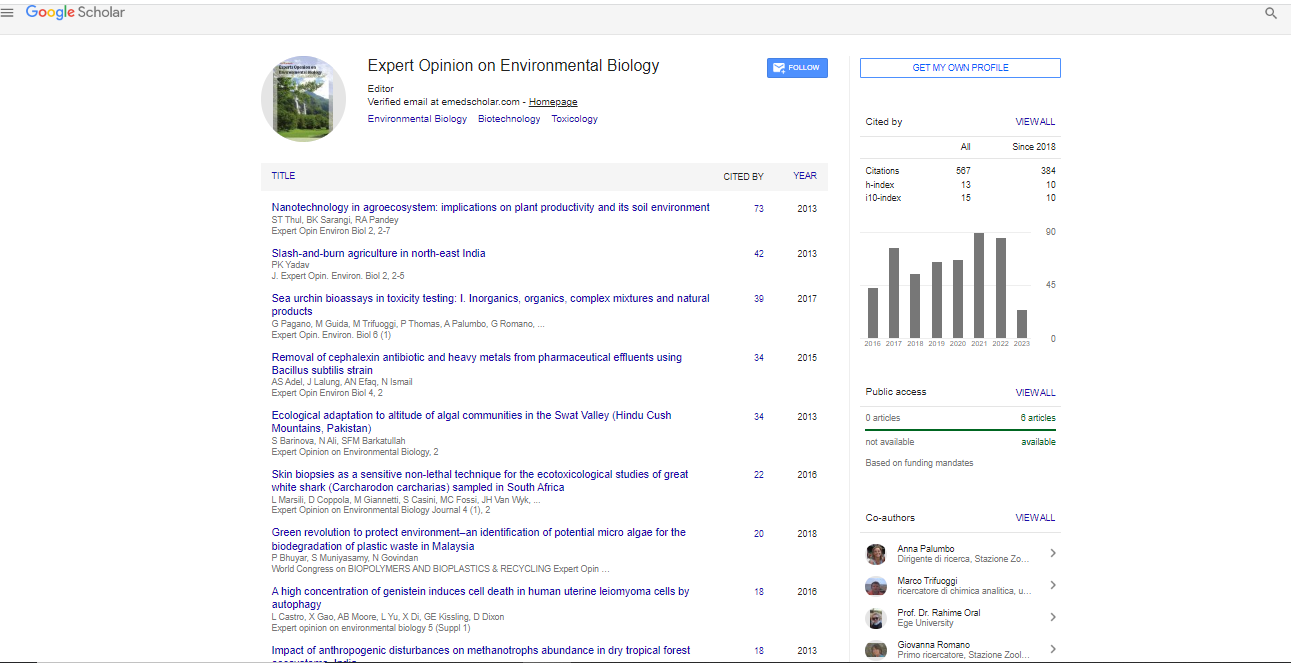Opinion Article, Expert Opin Environ Biol Vol: 13 Issue: 2
Examining Environmental Biotechnology and its Strategies for Sustainability
Fredering Carlesen*
1Department of Environmental Biology, Universidade de Santiago de Compostela, Spain, China
*Corresponding Author: Fredering Carlesen,
Department of Environmental Biology,
Universidade de Santiago de Compostela, Spain
E-mail: fredering_carlesen@uds21.es
Received date: 22 May, 2024, Manuscript No. EOEB-24-139825;
Editor assigned date: 24 May, 2024, PreQC No. EOEB-24-139825 (PQ);
Reviewed date: 07 June, 2024, QC No. EOEB-24-139825;
Revised date: 14 June, 2024, Manuscript No. EOEB-24-139825 (R);
Published date: 21 June, 2024, DOI: 10.4172/2325-9655.1000210
Citation: Carlesen F (2024) Examining Environmental Biotechnology and its Strategies for Sustainability. Expert Opin Environ Biol 13:2.
Description
In the search for sustainable solutions to environmental challenges, the field of environmental biotechnology has emerged as a powerful ally. Using the principles of biology and technology, experts and practitioners are pioneering innovative techniques that potential to revolutionize how one can manage and restore our ecosystems. It explores some of the new techniques in environmental biotechnology and their potential to promote sustainability. Microorganisms have long been recognized for their ability to degrade pollutants, produce renewable energy, and enhance nutrient cycling in ecosystems. Recent advancements in environmental biotechnology have focused on utilising the power of microbial communities through various techniques.
Bioremediation involves the use of microorganisms to detoxify and degrade contaminants in soil, water, and air. Techniques like bioaugmentation (introducing specialized microbial strains) and biostimulation (enhancing microbial activity through nutrient addition) are being refined to address a wide range of pollutants, including hydrocarbons, heavy metals, and pesticides. Microbial Fuel Cells (MFCs) control the metabolic activity of bacteria to generate electricity from organic matter. This technology shows potential for decentralized energy production in wastewater treatment plants, agricultural settings, and remote communities, providing a renewable alternative to fossil fuels.
Microorganisms can produce nanoparticles with unique properties that find applications in environmental remediation, such as removing heavy metals from contaminated sites. These biogenic nanoparticles are eco-friendly alternatives to conventional chemical methods. Advances in genetic engineering have expanded the toolkit of environmental biotechnologists, enabling targeted modifications to enhance the capabilities of organisms for sustainability. Synthetic biology applies engineering principles to design and construct biological systems for specific applications. In environmental biotechnology, this includes engineering microorganisms to produce biofuels, bioplastics, and enzymes for industrial processes, reducing reliance on fossil fuels and minimizing environmental impact.
CRISPR-Cas9 and other gene editing techniques offer precise control over microbial genomes, facilitating the development of strains optimized for environmental applications. Experts are exploring Genetically Modified Organisms (GMOs) designed to degrade pollutants more efficiently or tolerate harsh environmental conditions. Green chemistry principles emphasize the design of chemical products and processes that minimize environmental impact. Environmental biotechnology contributes to green chemistry through biocatalysis and enzymatic transformations. Enzymes derived from microorganisms or engineered through biotechnology can catalyze specific chemical reactions under mild conditions, reducing energy consumption and waste generation compared to traditional chemical methods. Applications range from industrial manufacturing to wastewater treatment.
Biotechnological approaches enable the production of bio-based materials from renewable feedstocks, providing sustainable alternatives to petroleum-derived plastics and chemicals. Biopolymers, biocomposites, and biofuels derived from agricultural residues or algae exemplify this tendency towards sustainable material science. The integration of big data analytics, Artificial Intelligence (AI), and sensor technologies is transforming environmental monitoring and decision-making in biotechnology. Advanced sensors enable real-time monitoring of environmental parameters such as pollutant concentrations, microbial activity, and ecosystem health. These data inform proactive management strategies and facilitate early detection of environmental threats.
AI algorithms analyze large datasets to predict environmental outcomes and optimize biotechnological processes. From predicting microbial behavior in contaminated sites to optimizing bioreactor performance, predictive modeling enhances efficiency and efficacy in environmental biotechnology applications. While these emerging techniques hold immense potential, challenges remain in scaling up technologies, ensuring regulatory compliance, and addressing ethical concerns surrounding genetic engineering and GMOs. Furthermore, interdisciplinary collaboration between biotechnologists, environmental experts, policymakers, and stakeholders is essential for translating studies into practical applications and fostering sustainable practices globally.
Conclusion
Emerging techniques in environmental biotechnology represent a change of opinion towards sustainable development, providing innovative solutions to complex environmental challenges. From controlling microbial diversity to engineering biological systems and producing digital technologies, these advancements emphasize the transformative potential of biotechnology in safeguarding ecosystems, promoting circular economies, and reducing climate change impacts. As studies continues to push boundaries and technology evolves, the future shows potential for a greener, more resilient planet shaped by the principles of environmental biotechnology. Through continued investment in studies, education, and policy support, stakeholders can accelerate the adoption of these technologies and pave the way towards a more sustainable future for generations to come.
 Spanish
Spanish  Chinese
Chinese  Russian
Russian  German
German  French
French  Japanese
Japanese  Portuguese
Portuguese  Hindi
Hindi 
